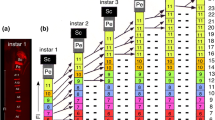Summary
The external and internal fine structure of the housefly interfacetal hair and its sensory dendrite was studied with the scanning and transmission (high and low voltage) electron microscopes. The hair shaft contains no dendrites, and is usually situated within a socket on the lens surface. Immediately beneath and directly connected to the base of each hair is a bipolar neuron whose dendrite tip is enveloped in a sheath cell which, in turn, is surrounded by a second sheath cell. Septate junctions are seen between all these cells and contiguous portions of a large pigment cell. At the hair base, the dendrite of the neuron terminates in a tubular body only 1.5 μm in diameter which is filled with about 400 microtubules in highly ordered (in parallel pentagonal and hexagonal) arrays and whose sides are fused to neurofilaments in parallel. Another filament (ca. 70 Å diameter) is in the center of each microtubule-neurofilament polygon. Structures proximal to the tubular body are typical for a scolopoid sensillum, i.e., connecting cilium (9×2+0 microtubules) with rootlet and basal bodies, unmodified dendrite, perikaryon and axon. The axon has not been traced to its synapse. The high degree of internal organization and shortness of the tubular body, as well as its eccentric insertion into the hair shaft lead to the hypothesis that this hair may be a highly sensitive mechanoreceptor. On the basis of their single innervation, these hairs could monitor flight speed from the degree of hair deflection caused by wind in general or particular laminar air currents flowing past the eyes during flight.
Similar content being viewed by others
References
Camhi, J.M.: Locust wind receptors. I. Transducers, mechanics and sensory response. J. exp. Biol. 50, 335–348 (1968a)
Camhi, J.M.: Locust wind receptors. II. Interneurons in the cervical connective. J. exp. Biol. 50, 349–362 (1969b)
Gaffal, K.P., Hansen, K.: Mechanorezeptive Strukturen der antennalen Haarsensillen der Baumwollwanze Dysdercus intermedius Dist. Z. Zellforsch. 132, 79–94 (1972)
Guthrie, D.M.: The function and fine structure of the cephalic airflow receptor in Schistocerca gregaria. J. Cell Sci. 1, 463–470 (1966)
Hinton, H.E.: Some little known surface structures. In: Insect Ultrastructure (ed. A.C. Neville), p. 41–58. Symp. Roy. Ento. Soc. Lond. 5. Blackwell Scientific Publ. Oxford. U. 1970
McIver, S.B.: Structure of cuticular mechanoreceptors of arthropods. Ann. Rev. Ent. 20, 381–397 (1975)
Neese, V.: Zur Funktion der Augenborsten bei der Honigbiene. Z. vergl. Physiol. 49, 543–585 (1965)
Neese, V.: Zur Bedeutung der Augenborsten bei der Fluggeschwindigkeitsregulation der Bienen. Z. vergl. Physiol. 52, 149–154 (1966)
Rice, M.J., Galun, R., Finlayson, L.H.: Mechanotransduction in insect neurons. Nature (Lond.). New Biol. 241, 286–288 (1973)
Schwartzkoff, J.: Mechanoreception. In: Physiology of Insecta (M. Rockstein ed.), vol. II, p. 273–352. New York: Academic Press 1974
Smith, D.S.: The fine structure of haltere sensilla in the blowfly Calliphora erythrocephala (Meig.), with scanning electron microscopic observations on the haltere surface. Tiss. Cell 1 (3), 443–484 (1969)
Strickler, J.R., Bal, A.K.: Setae of the first antennae of the copepod Cyclops scrutifer (Sars). Their structure and importance. Proc. nat. Acad. Sci. (Wash.) 70, 2656–2659 (1973)
Thurm, U.: Die Beziehungen zwischen mechanischen Reizgrößen und stationären Erregungszuständen bei Borstenfeld-Sensillen von Bienen. Z. vergl. Physiol. 46, 351–382 (1963)
Thurm, U.: An insect mechanoreceptor. Part I: Fine structure and adequate stimulus. Cold Spr. Harb. Symp. quant. Biol. 30, 75–82 (1965)
Thurm, U.: The generation of receptor potentials in epithelial receptors. In: Olfaction and Taste IV. (ed. D. Schneider) 95–101. Stuttgart, Wissenschaftliche Verlagsgesellschaft mbH. 400pp. (1972)
Author information
Authors and Affiliations
Additional information
We are especially grateful for support from the University of Wisconsin Graduate School, Project 160392 and the College of Agricultural and Life Sciences, Hatch Project No. 1916. Mr. Gary Gaard and Mr. Martin Garment helped in TEM and SEM-darkroom procedures, respectively. For assistance with the HVEM we heartily thank the following members of the Department of Zoology: Professor Hans Ris for his consent to the project, Associate Professor Dale E. Johnson, Physicist in charge, and Dr. Damian S. Neuberger, Specialist. We are most appreciative of a critical reading of this manuscript by Professor R.W. Guillery, Department of Anatomy.
Rights and permissions
About this article
Cite this article
Chi, C., Carlson, S.D. The housefly interfacetal hair. Cell Tissue Res. 166, 353–363 (1976). https://doi.org/10.1007/BF00220131
Received:
Issue Date:
DOI: https://doi.org/10.1007/BF00220131




